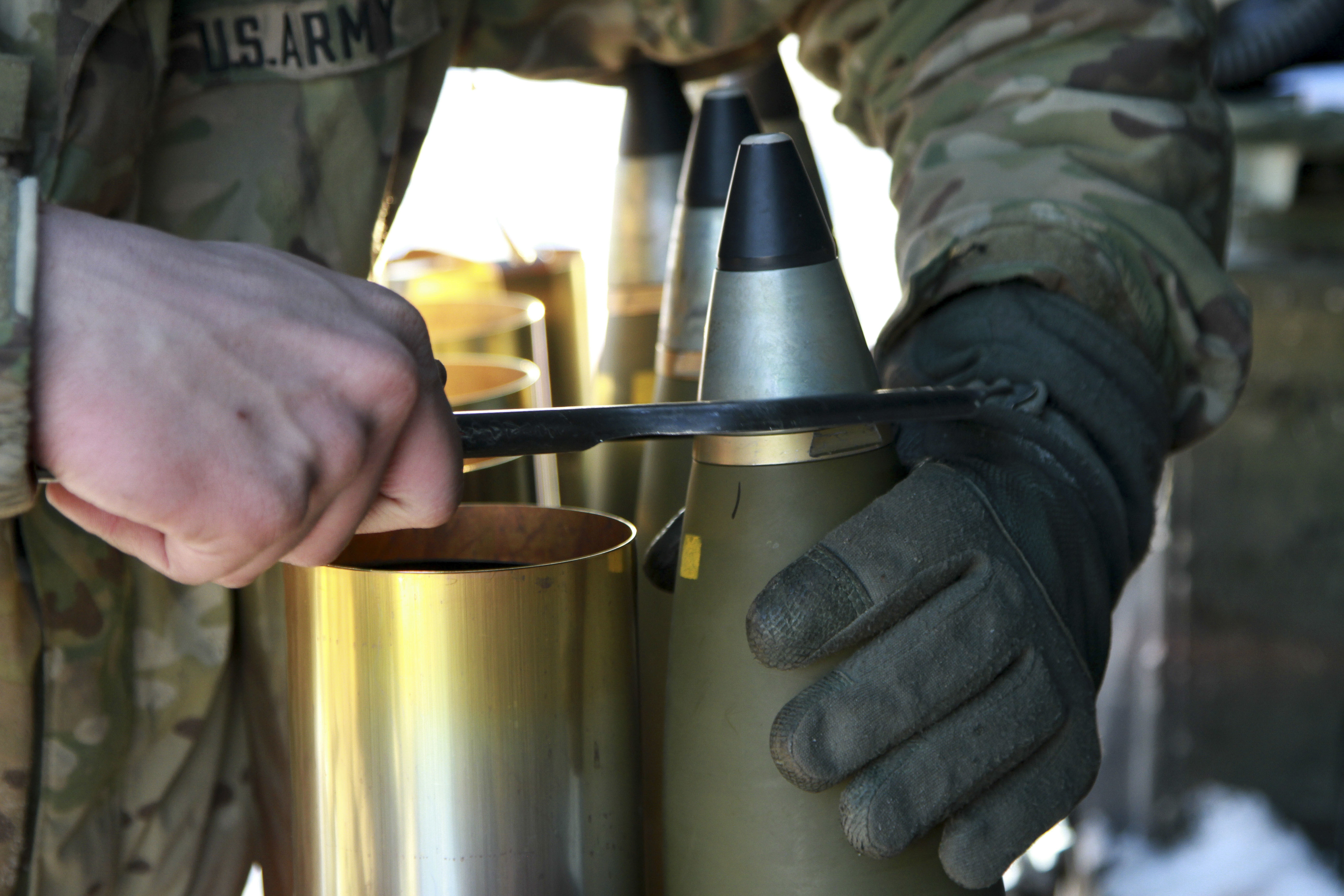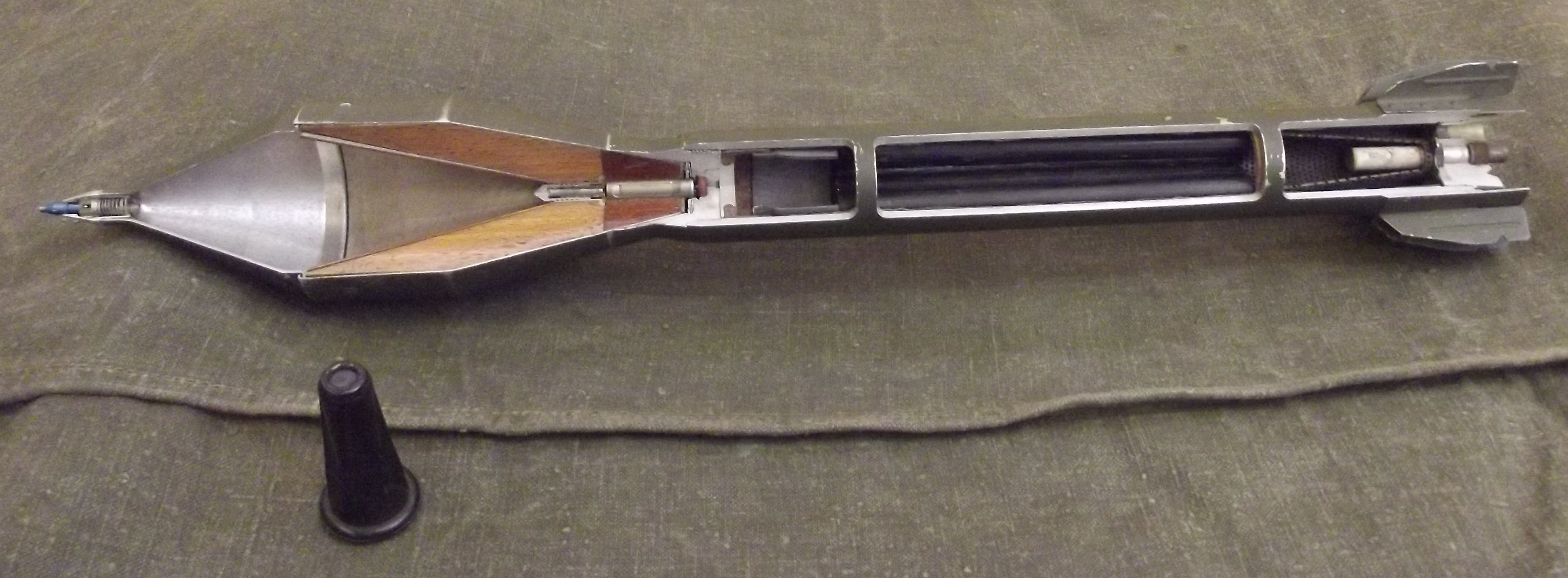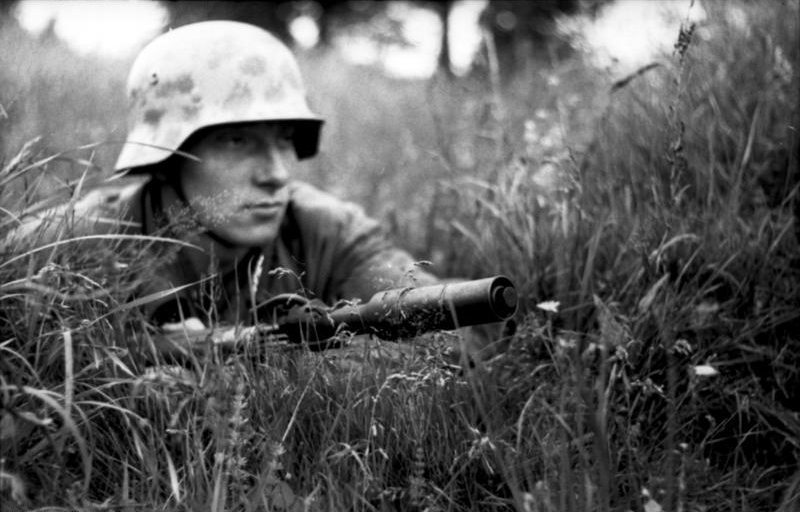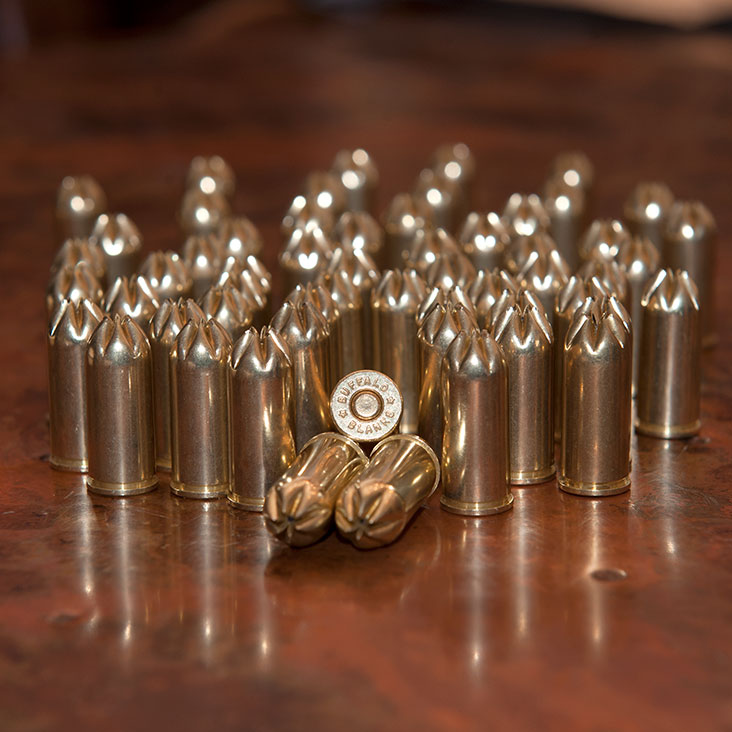|
Gewehr-Panzergranate
The Gewehr-Panzergranate was a shaped charge rifle grenade that was developed by Germany and used by the Wehrmacht during World War II. Design The Gewehr-Panzergranate was launched from a Gewehrgranatengerät or Schiessbecher ("shooting cup") on a standard service rifle by a blank cartridge. The primary components were a nose cap, internal steel cone, steel upper body, aluminum lower body, rifled driving band, TNT filling, and a PETN base fuze. The Gewehr-Panzergranate was an anti-armor weapon which upon hitting the target ignited the PETN base fuze which in turn ignited the TNT filling which collapsed the internal steel cone to create a superplastic In materials science, superplasticity is a state in which solid crystalline material is deformed well beyond its usual breaking point, usually over about 600% during tensile deformation. Such a state is usually achieved at high homologous tempe ... high-velocity jet to punch through enemy armor. Since shaped charge weapo ... [...More Info...] [...Related Items...] OR: [Wikipedia] [Google] [Baidu] |
Shaped Charge
A shaped charge is an explosive charge shaped to form an explosively formed penetrator (EFP) to focus the effect of the explosive's energy. Different types of shaped charges are used for various purposes such as cutting and forming metal, initiating nuclear weapons, penetrating armor, or perforating wells in the oil and gas industry. A typical modern shaped charge, with a metal liner on the charge cavity, can penetrate armor steel to a depth of seven or more times the diameter of the charge (charge diameters, CD), though greater depths of 10 CD and above have been achieved. Contrary to a misconception (possibly resulting from the acronym for ''high-explosive anti-tank'', HEAT) the shaped charge EFP jet does not depend in any way on heating or melting for its effectiveness; that is, the EFP jet from a shaped charge does not melt its way through armor, as its effect is purely kinetic in nature – however the process does create significant heat and often has a significant ... [...More Info...] [...Related Items...] OR: [Wikipedia] [Google] [Baidu] |
Rifle Grenade
A rifle grenade is a grenade that uses a rifle-based launcher to permit a longer effective range than would be possible if the grenade were thrown by hand. The practice of projecting grenades with rifle-mounted launchers was first widely used during World War I and World War II and continues to the present, with the term "rifle grenade" now encompassing many different types of payloads including high explosive, fragmentation, anti-tank warheads, concussion, smoke, incendiary, and flare missiles. Rifle grenades have largely been supplanted in the infantry fire support role by a combination of grenade launchers (typically affixed to rifles) and disposable anti-armor rockets. History Early use Adaptation of grenades for use in rifles began around the 18th century, when cup-shaped dischargers were fitted to the barrels of flintlock muskets, with the grenades propelled by the force of a blank cartridge. During the early 20th century a Japanese Colonel Amazawa experimented ... [...More Info...] [...Related Items...] OR: [Wikipedia] [Google] [Baidu] |
Wehrmacht
The ''Wehrmacht'' (, ) were the unified armed forces of Nazi Germany from 1935 to 1945. It consisted of the ''Heer'' (army), the ''Kriegsmarine'' (navy) and the ''Luftwaffe'' (air force). The designation "''Wehrmacht''" replaced the previously used term and was the manifestation of the Nazi regime's efforts to rearm Germany to a greater extent than the Treaty of Versailles permitted. After the Nazi rise to power in 1933, one of Adolf Hitler's most overt and audacious moves was to establish the ''Wehrmacht'', a modern offensively-capable armed force, fulfilling the Nazi régime's long-term goals of regaining lost territory as well as gaining new territory and dominating its neighbours. This required the reinstatement of conscription and massive investment and defense spending on the arms industry. The ''Wehrmacht'' formed the heart of Germany's politico-military power. In the early part of the Second World War, the ''Wehrmacht'' employed combined arms tactics (close-cover ... [...More Info...] [...Related Items...] OR: [Wikipedia] [Google] [Baidu] |
World War II
World War II or the Second World War, often abbreviated as WWII or WW2, was a world war that lasted from 1939 to 1945. It involved the vast majority of the world's countries—including all of the great powers—forming two opposing military alliances: the Allies and the Axis powers. World War II was a total war that directly involved more than 100 million personnel from more than 30 countries. The major participants in the war threw their entire economic, industrial, and scientific capabilities behind the war effort, blurring the distinction between civilian and military resources. Aircraft played a major role in the conflict, enabling the strategic bombing of population centres and deploying the only two nuclear weapons ever used in war. World War II was by far the deadliest conflict in human history; it resulted in 70 to 85 million fatalities, mostly among civilians. Tens of millions died due to genocides (including the Holocaust), starvation, ma ... [...More Info...] [...Related Items...] OR: [Wikipedia] [Google] [Baidu] |
Pentaerythritol Tetranitrate
Pentaerythritol tetranitrate (PETN), also known as PENT, PENTA, (ПЕНТА, primarily in Russian) TEN, corpent, or penthrite (or, rarely and primarily in German, as nitropenta), is an explosive material. It is the nitrate ester of pentaerythritol, and is structurally very similar to nitroglycerin. Penta refers to the five carbon atoms of the neopentane skeleton. PETN is a very powerful explosive material with a relative effectiveness factor of 1.66. When mixed with a plasticizer, PETN forms a plastic explosive. Along with RDX it is the main ingredient of Semtex. PETN is also used as a vasodilator drug to treat certain heart conditions, such as for management of angina. History Pentaerythritol tetranitrate was first prepared and patented in 1894 by the explosives manufacturer Rheinisch-Westfälische Sprengstoff A.G. of Cologne, Germany. The production of PETN started in 1912, when the improved method of production was patented by the German government. PETN was used by the Germ ... [...More Info...] [...Related Items...] OR: [Wikipedia] [Google] [Baidu] |
Artillery Fuze
An artillery fuze or fuse is the type of munition fuze used with artillery munitions, typically projectiles fired by guns (field, anti-aircraft, coast and naval), howitzers and mortars. A fuze is a device that initiates an explosive function in a munition, most commonly causing it to detonate or release its contents, when its activation conditions are met. This action typically occurs a preset time after firing ( time fuze), or on physical contact with (contact fuze) or detected proximity to the ground, a structure or other target ( proximity fuze). Fuze, a variant of fuse, is the official NATO spelling. Terminology Munitions fuzes are also used with rockets, aircraft bombs, guided missiles, grenades and mines, and some direct fire cannon munitions (small calibre and tank guns). Broadly, fuzes function on impact (percussion fuzes) or at a pre-determined time period after firing (time fuzes). However, by the 18th century time fuzes were aimed to function in the air and in the ... [...More Info...] [...Related Items...] OR: [Wikipedia] [Google] [Baidu] |
Rolled Homogeneous Armour
Rolled homogeneous armour (RHA) is a type of vehicle armour made of a single steel composition hot-rolled to improve its material characteristics, as opposed to layered or cemented armour. Its first common application was in tanks. After World War II, it began to fall out of use on main battle tanks and other armoured fighting vehicles intended to see front-line combat as new anti-tank weapon technologies were developed which were capable of relatively easily penetrating rolled homogeneous armour plating even of significant thickness. Today, the term is primarily used as a unit of measurement of the protection offered by armour on a vehicle (often composed of materials that may not actually contain steel, or even contain any metals) in equivalent ''millimetres of RHA'', referring to the thickness of RHA that would provide the same protection. Typically, modern composite armour can provide the same amount of protection with much thinner and lighter construction than its protectiv ... [...More Info...] [...Related Items...] OR: [Wikipedia] [Google] [Baidu] |
Shaped Charge
A shaped charge is an explosive charge shaped to form an explosively formed penetrator (EFP) to focus the effect of the explosive's energy. Different types of shaped charges are used for various purposes such as cutting and forming metal, initiating nuclear weapons, penetrating armor, or perforating wells in the oil and gas industry. A typical modern shaped charge, with a metal liner on the charge cavity, can penetrate armor steel to a depth of seven or more times the diameter of the charge (charge diameters, CD), though greater depths of 10 CD and above have been achieved. Contrary to a misconception (possibly resulting from the acronym for ''high-explosive anti-tank'', HEAT) the shaped charge EFP jet does not depend in any way on heating or melting for its effectiveness; that is, the EFP jet from a shaped charge does not melt its way through armor, as its effect is purely kinetic in nature – however the process does create significant heat and often has a significant ... [...More Info...] [...Related Items...] OR: [Wikipedia] [Google] [Baidu] |
Nazi Germany
Nazi Germany (lit. "National Socialist State"), ' (lit. "Nazi State") for short; also ' (lit. "National Socialist Germany") (officially known as the German Reich from 1933 until 1943, and the Greater German Reich from 1943 to 1945) was the German state between 1933 and 1945, when Adolf Hitler and the Nazi Party controlled the country, transforming it into a dictatorship. Under Hitler's rule, Germany quickly became a totalitarian state where nearly all aspects of life were controlled by the government. The Third Reich, meaning "Third Realm" or "Third Empire", alluded to the Nazi claim that Nazi Germany was the successor to the earlier Holy Roman Empire (800–1806) and German Empire (1871–1918). The Third Reich, which Hitler and the Nazis referred to as the Thousand-Year Reich, ended in May 1945 after just 12 years when the Allies defeated Germany, ending World War II in Europe. On 30 January 1933, Hitler was appointed chancellor of Germany, the head of gove ... [...More Info...] [...Related Items...] OR: [Wikipedia] [Google] [Baidu] |
Schiessbecher & Rifle Grenade (Gewehr Panzergranaten)
The Schiessbecher (alternatively: ''Schießbecher'') - literally "shooting cup" - was a German grenade launcher of World War II. A ''Gewehrgranatgerät'' ("rifle grenade device") based on rifle grenade launcher models designed during World War I it fitted to the end of a rifle, the grenade being propelled by a special rifle cartridge. The ''Schiessbecher'' was introduced in 1942 and intended to replace all previous rifle grenade launcher models in use by German armed forces. The ''Schiessbecher'' rifle grenade launcher could be used against infantry, fortifications and light armored vehicles up to a range of . For these differing tasks several specialized grenades with accompanying special propelling cartridges were developed for the ''Schiessbecher''. The rifle grenade propelling cartridges fired a wooden projectile through the barrel to the rifle grenade that upon impact automatically primed the rifle grenade. The ''Schiessbecher'' had a short rifled barrel with a caliber of ... [...More Info...] [...Related Items...] OR: [Wikipedia] [Google] [Baidu] |
Schiessbecher
The Schiessbecher (alternatively: ''Schießbecher'') - literally "shooting cup" - was a German grenade launcher of World War II. A ''Gewehrgranatgerät'' ("rifle grenade device") based on rifle grenade launcher models designed during World War I it fitted to the end of a rifle, the grenade being propelled by a special rifle cartridge. The ''Schiessbecher'' was introduced in 1942 and intended to replace all previous rifle grenade launcher models in use by German armed forces. The ''Schiessbecher'' rifle grenade launcher could be used against infantry, fortifications and light armored vehicles up to a range of . For these differing tasks several specialized grenades with accompanying special propelling cartridges were developed for the ''Schiessbecher''. The rifle grenade propelling cartridges fired a wooden projectile through the barrel to the rifle grenade that upon impact automatically primed the rifle grenade. The ''Schiessbecher'' had a short rifled barrel with a caliber of ... [...More Info...] [...Related Items...] OR: [Wikipedia] [Google] [Baidu] |
Blank Cartridge
A blank is a firearm cartridge that, when fired, does not shoot a projectile like a bullet or pellet, but generates a muzzle flash and an explosive sound ( muzzle report) like a normal gunshot would. Firearms may need to be modified to allow a blank to cycle the action, and the shooter experiences less recoil with a blank than with a live round. Blanks are often used in prop guns for shooting simulations that have no need for ballistic results, but still demand light and sound effects, such as in historical reenactments, special effects for theatre, movie and television productions, combat training, for signaling (see starting pistol), and cowboy mounted shooting. Specialised blank cartridges are also used for their propellant force in fields as varied as construction, shooting sports, and fishing and general recreation. While blanks are less dangerous than live ammunition, they are dangerous and can still cause fatal injuries. Beside the explosive gases, any objects in the cartri ... [...More Info...] [...Related Items...] OR: [Wikipedia] [Google] [Baidu] |
.png)







